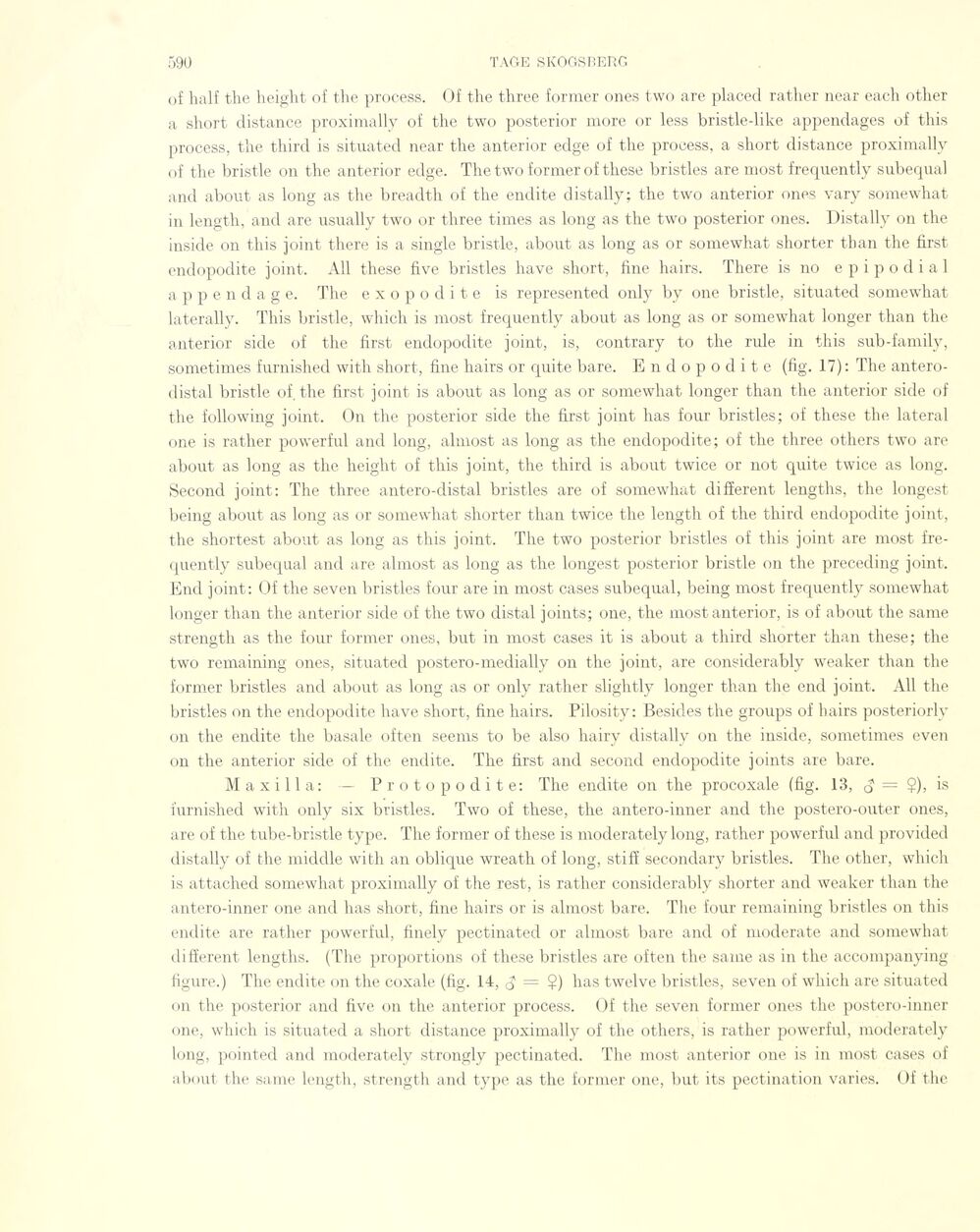
Full resolution (JPEG) - On this page / på denna sida - Sidor ...

<< prev. page << föreg. sida << >> nästa sida >> next page >>
Below is the raw OCR text
from the above scanned image.
Do you see an error? Proofread the page now!
Här nedan syns maskintolkade texten från faksimilbilden ovan.
Ser du något fel? Korrekturläs sidan nu!
This page has never been proofread. / Denna sida har aldrig korrekturlästs.
of half the height of the process. Of the three former ones two are placée! rather near each other
a short distance proximally of the two posterior more or less bristle-like appendages of this
process, the third is situated near the anterior edge of the process, a short distance proximally
of the bristle on the anterior edge. The two former of these bristles are most frequently subequal
and about as long as the breadth of the endite distally; the two anterior ones vary somewhat
in length, and are usually two or three times as long as the two posterior ones. Distally on the
inside on this joint there is a single bristle, about as long as or somewhat shorter than the first
endopodite joint. Ail these five bristles have short, fine hairs. There is no e p i p o d i a 1
appendage. The exopodite is represented only by one bristle, situated somewhat
laterally. This bristle, which is most frequently about as long as or somewhat longer than the
anterior side of the first endopodite joint, is, contrary to the rule in this sub-family,
sometimes furnished with short, fine hairs or quite bare. Endopodite (fig. 17) : The
antero-distal bristle of, the first joint is about as long as or somewhat longer than the anterior side of
the foliowing joint. On the posterior side the first joint has four bristles; of these the lateral
one is rather powerful and long, almost as long as the endopodite; of the three others two are
about as long as the height of this joint, the third is about twice or not quite twice as long.
Second joint: The three antero-distal bristles are of somewhat different lengths, the longest
being about as long as or somewhat shorter than twice the length of the third endopodite joint,
the shortest about as long as this joint. The two posterior bristles of this joint are most
frequently subequal and are almost as long as the longest posterior bristle on the preceding joint.
End joint: Of the seven bristles four are in most cases subequal, being most frequently somewhat
longer than the anterior side of the two distal joints; one, the most anterior, is of about the same
strength as the four former ones, but in most cases it is about a third shorter than these; the
two remaining ones, situated postero-medially on the joint, are considerably weaker than the
former bristles and about as long as or only rather slightly longer than the end joint. Ail the
bristles on the endopodite have short, fine hairs. Pilosity: Besides the groups of hairs posteriorly
on the endite the basale often seems to be also hairy distally on the inside, sometimes even
on the anterior side of the endite. The first and second endopodite joints are bare.
Maxilla: — Pr o topodit e: The endite on the procoxale (fig. 13, q — $), is
furnished with only six bristles. Two of these, the antero-inner and the postero-outer ones,
are of the tube-bristle type. The former of these is moderately long, rather powerful and provided
distally of the middle with an oblique wreath of long, stifE secondary bristles. The other, which
is attached somewhat proximally of the rest, is rather considerably shorter and weaker than the
antero-inner one and has short, fine hairs or is almost bare. The four remaining bristles on this
endite are rather powerful, finely pectinated or almost bare and of moderate and somewhat
different lengths. (The proportions of these bristles are often the same as in the accompanying
figure.) The endite on the coxale (fig. 14, = $) has twelve bristles, seven of which are situated
on the posterior and five on the anterior process. Of the seven former ones the postero-inner
one, which is situated a short distance proximally of the others, is rather powerful, moderately
long, pointed and moderately strongly pectinated. The most anterior one is in most cases of
about the same length, strength and type as the former one, but its pectination varies. Of the
<< prev. page << föreg. sida << >> nästa sida >> next page >>